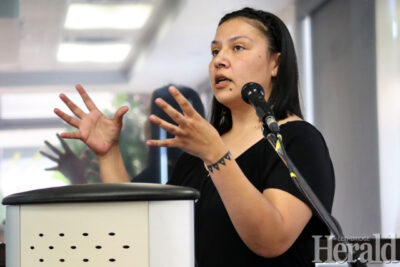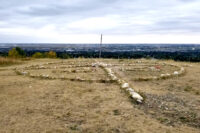Battle of the Belly River project in spotlight at SACPA
By Al Beeber - Lethbridge Herald on April 14, 2023.
 Herald photo by Al Beeber
Camina Weasel Moccasin of the Galt Museum speaks about the Battle of the Belly River Project during Thursday's SACPA session.
Herald photo by Al Beeber
Camina Weasel Moccasin of the Galt Museum speaks about the Battle of the Belly River Project during Thursday's SACPA session.LETHBRIDGE HERALDabeeber@lethbridgeherald.com
A project that looks at the historic Battle of the Belly River from an Indigenous perspective was the focus of Thursday’s talk to the Southern Alberta Council on Public Affairs.
Camina Weasel Moccasin of the Galt Museum and Kris Hodgson-Bright of Lethbridge College gave a joint presentation on the Battle of the Belly River Project which utilizes storytelling and virtual reality to present the story in a new light.
The Battle of the Belly River on Oct. 25, 1870 was the last major battle between First Nations on Canadian soil and the last major fight between the Blackfoot Confederacy and the Cree.
It was fought within what are now the city limits of Lethbridge on the banks of the Oldman River.
Three publications have been written about the conflict, all from the perspective of settlers/colonists. According to the Galt Museum & Archives, the knowledge and history of the fight live on to this day in Blackfoot communities with many families having stories of their ancestors’ personal involvement.
In partnership with Lethbridge College, the City of Lethbridge and Reconciliation Lethbridge, the Galt has embarked on a project that focuses on the Niitsitapi perspectives of the battle which it believes “will continue efforts toward reconciliation and relationship building by informing residents of the impact the battle had on the development of Lethbridge.”
The project’s goal, SACPA was told, is a hope to amplify voices and help “to bring Indigenous students, Elders and Knowledge Keepers together to share the stories that belong and will always belong to them.”
Weasel Moccasin told the audience she’s grateful to have the opportunity to work on the project.
The three previous publications for the most part “talk about this event from the settler/colonial perspective. With this project happening now in 2023, starting in 2022, we wanted to really highlight Niitsitapi knowledge and voices around this project and this event.”
Weasel Moccasin, who has worked in heritage management for the last 15 years, said the project has opened her eyes “to the different cultural understandings of this one event but also the reasoning behind the outcome of the event.”
The project is working with the three Blackfoot Nations in Canada.
Hodgson-Bright, who has spent the last 11 years at the college, said this project has been the most meaningful one he’s worked on.
“I’ve really been working with Camina to make sure that we proceed in the right direction and with the right guidance to make sure this is a very thoughtful and kind project that really takes all those perspectives from the Blackfoot people into consideration and make sure that we present it in a way that’s very thoughtful and meaningful,” said the college instructor.
At the college, he was part of a committee that was looking at the best ways to move forward with Truth and Reconciliation and on that committee was Perry Stein from the City who had the idea to get Hodgson-Bright involved with this project, he related.
The perspective Hodgson-Bright brings to the project is the idea of immersive storytelling.
“A broader understanding from the previous publications is that this story is both a collective story for the tribes, but there are also individual stories. So families of individuals who were involved in this event, they then have those personal experiences that are then handed down in the families. So those are some of the stories that we are really trying to capture,” said Weasel Moccasin.
Among the themes that have emerged is some Blackfoot names originate from that battle, she said.
The first phase going on right now involves engaging with the community to gather stories, SACPA heard. By next year, the project will move into the second phase when it will consider what to do with all the great content that has been developed, she said.
Previous publications talk about the victory of the event being the weapons that the Blackfoot had. They already had access to repeating rifles which was a better technology than the musket that the Cree used, said Weasel Moccasin.
“But in talking with Elders, that’s never really brought up as the reason that the victory happened for the Blackfoot people. A lot of stories that I’m hearing, the reasons the victory had happened are actually spiritual reasons and the spiritual connection Blackfoot people have,” Weasel Moccasin told the audience.
Among lingering questions Weasel Moccasin has that haven’t been answered, she said, is where the women and children were during the battle.
One story she has heard from her own family is that her great-great-grandmother pulled a butcher knife from under her pillow and stabbed a Cree who had entered her tipi, saving herself and her children.
Hodgson-Bright said another question is how does immersive technology fit into traditional Indigenous storytelling – a question which is being addressed in focus groups.
“Does it really make sense to tell stories this way,?” he asked.
“Will young people like to engage in hearing about stories about their ancestors and the history of the Blackfoot culture through virtual reality?”
From what he’s heard already from focus groups, it’s more special sitting in a tipi and hearing in person from Elders.
“That’s been really interesting to hear,” he said.
Weasel Moccasin wants to make sure the voices of Indigenous women are heard and their presence known in the project.
So one thing she suggested to Hodgson-Bright is that traditional dancer Edna Bad Eagle and narrator Shirlee Crowshoe be included.
It was important to Weasel Moccasin for traditional dance to be involved “because the dance itself is meant to honour warriors. This is something that Elders had mentioned – when the men would come back from a war raid, the women would stand outside and they would dance as their way to honour what these men had done and were able to make it back home.”
Elder Crowshoe is narrating the content for the VR program.
“A lot of the stories are very male focused and I’m wanting to contradict that by having a female narrate some of these events,” Weasel Moccasin added.
Follow @albeebHerald on Twitter
35-34




